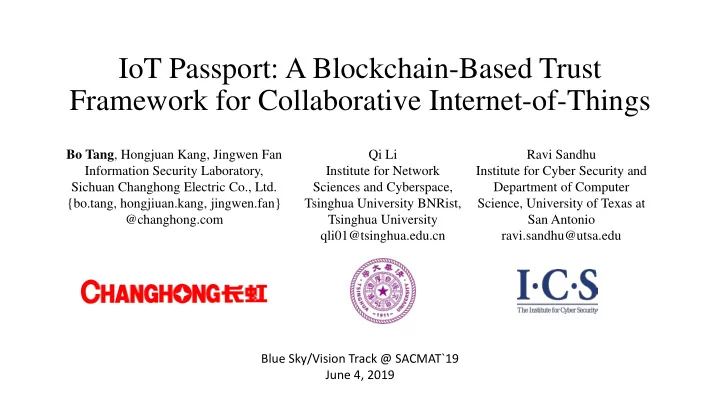

IoT Passport: A Blockchain-Based Trust Framework for Collaborative Internet-of-Things Bo Tang , Hongjuan Kang, Jingwen Fan Qi Li Ravi Sandhu Information Security Laboratory, Institute for Network Institute for Cyber Security and Sichuan Changhong Electric Co., Ltd. Sciences and Cyberspace, Department of Computer {bo.tang, hongjiuan.kang, jingwen.fan} Tsinghua University BNRist, Science, University of Texas at @changhong.com Tsinghua University San Antonio qli01@tsinghua.edu.cn ravi.sandhu@utsa.edu Blue Sky/Vision Track @ SACMAT`19 June 4, 2019
More “Things” than Human • Passed a single connected object per person in 2008 and projected to 26 smart objects per human by 2020 * . • What will be the foreseeable outcome? • AI helps us control objects in the background • Multi-factor User Interface with sensors • Collaborative IoT: things talk to each other * S. Elbouanani, M. El Kiram, and O. Achbarou. 2015. Introduction to the Internet of Things security: Standardization and research challenges. In 2015 11th International Conference on Information Assurance and Security. IEEE, 32–37.
Smart Life • Ubiquitous physical infrastructure with sensors and actuators • Everything Connected • Lifestyle with smart things towards better life
User Scenarios • S1 . On the way home, Alice converses with the AI assistant on her smart phone to check her food inventory. The smart refrigerator responds with a list and suggestions on grocery shopping. Moreover, the AI assistant provides a one-click option for same-day delivery. • S2 . The facial detectors at Alice’s authenticate her on arrival and further detect her mood as currently blue, so yellow lights will turn on and soft sound tracks from her favorites will play.
Inevitable Cross-Platform Collaboration • Fragmented user needs inevitably lead to diverse brands and models of devices along time. • Collaboration costs multiply with scenarios for on-device solutions but hardware capabilities are limited.
Centralized vs Decentralized (a) Centralized solution: a single application manages (b) Decentralized solution: a distributed application collaboration among the participating devices and manages collaborative commands over the DCN platforms
Goals • Security Requirements • Key objectives • Decentralized Trust Framework • Agreements between Platforms • Access Control and Data Security • Security and Privacy • Hierarchical Synchronization • Efficiency and Scalability • Incentive Policies • Sustainable Ecosystem
Federated Trust Requirements • across platforms • Compatible with business needs and doubts • Transparency in data governance policy enforcement • Proper authority with managed devices (device citizenship) • User privacy concern properly addressed and enforced • across devices • Federated authentication mechanisms • Authorization decisions are made in decentralized fashion
Related Works • Centralized authentication and authorization for IoT • N. Ye et al. 2014. An efficient authentication and access control scheme for perception layer of internet of things. Appl. Math. & Info. Sci. 8, 4 (2014), 1–8. • Maanak Gupta and Ravi Sandhu. 2018. Authorization Framework for Secure Cloud Assisted Connected Cars and Vehicular Internet of Things. In 23rd ACM on Symposium on Access Control Models and Technologies. ACM, 193–204. • Measurement-based trust models • Audun Jøsang. 2001. A logic for uncertain probabilities. International Journal of Uncertainty, Fuzziness and Knowledge-Based Systems 9, 03 (2001), 279–311. • Y. Ruan, A. Durresi, and L. Alfantoukh. 2016. Trust management framework for internet of things. In IEEE Conf. on Advanced Info. Nw. and Apps. 1013–1019. • Distributed access control using blockchain • Jollen Chen. 2018. Hybrid blockchain and pseudonymous authentication for secure and trusted IoT networks. ACM SIGBED Review 15, 5 (2018), 22–28. • Attribute-Based Access Control • Ravi Sandhu. 2012. The authorization leap from rights to attributes: maturation or chaos?. In 17th ACM SACMAT. ACM, 69–70. • S. Sciancalepore et al. 2016. Attribute-based access control scheme in federated IoT platforms. In Wkshp. on Interoperability and Open-Source Solutions. 123–138.
Design Overview Blockchain-Based Trust Framework (BBTF) in layers
IoT Passport
Hierarchical Trust Domains • CAP Theorem selection: SC • Scalability • Consistency • Loose Decentralization on the Edge
Blockchain-Based Access Control • Attribute-Based Access Control • Take subject attributes, object attributes and environment conditions into access evaluation • Blockchain guarantees the integrity, availability and non-repudiation of attributes • Attributes retrievable from blockchain and participating platforms • Provenance-Based Access Control • Use provenance data as attributes • Persistent storage and proper sharing of the provenance data on blockchain
Incentive Policies • Service-based • Service provider rewarded by consumer • Capability-based • Capability provider rewarded by consumer • Ecosystem-based • Public rankings of collaboration
Proposed Security Focused Research Agenda • Context-aware access control for IoT • Cross-platform trust models • On-blockchain policy administration and verification • Data on the Edge
Summary • With the booming Internet of Things, cross-platform collaboration becomes inevitable • Centralized solutions have limitations turning to decentralization • Decentralized trust framework using blockchain • IoT Passport • Hierarchical trust domains for better scalability and efficiency • Blockchain-based access control better enforcement with attributes • Incentive policies establish sustainable ecosystem • Proposed security focused research agenda
Recommend
More recommend